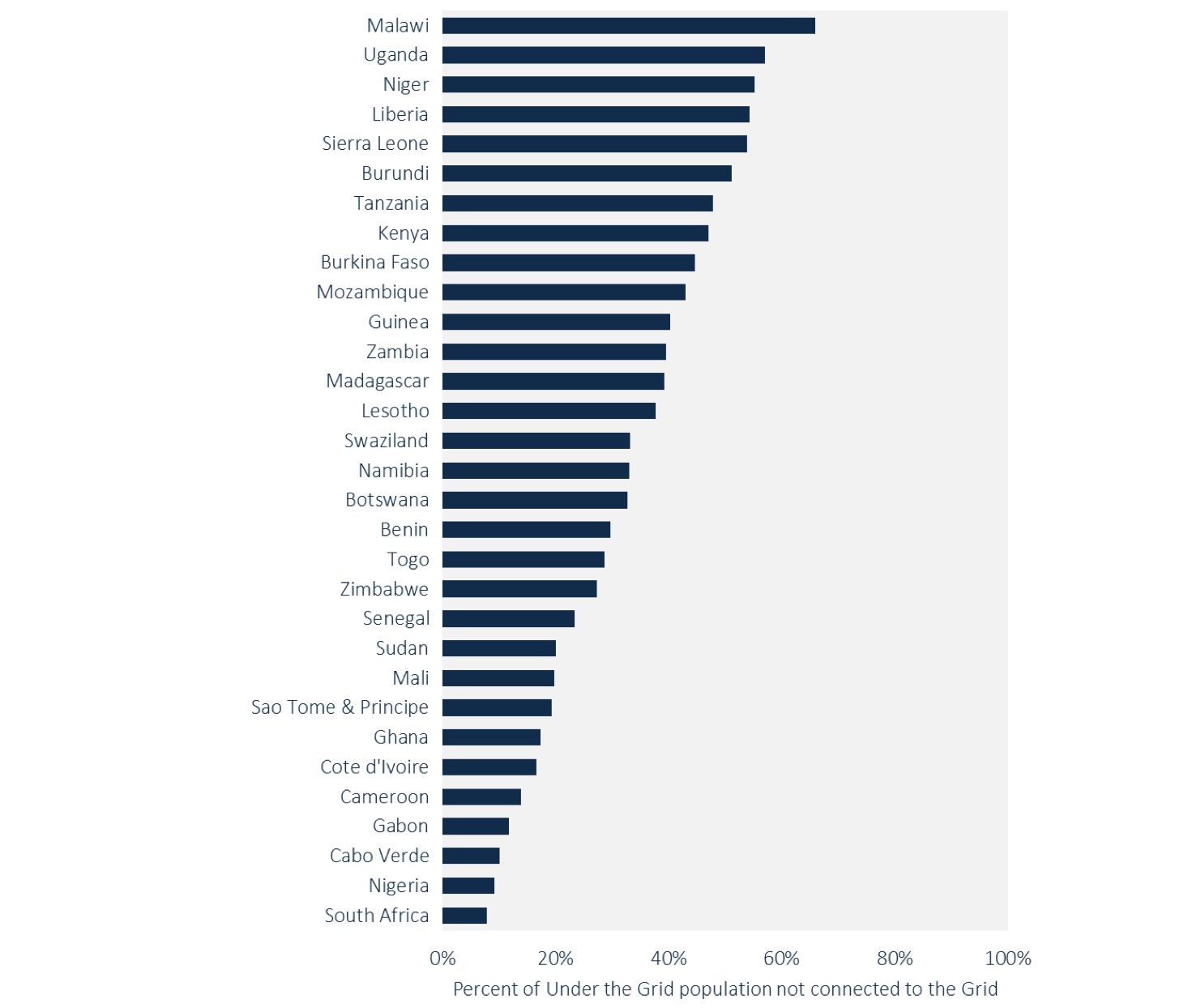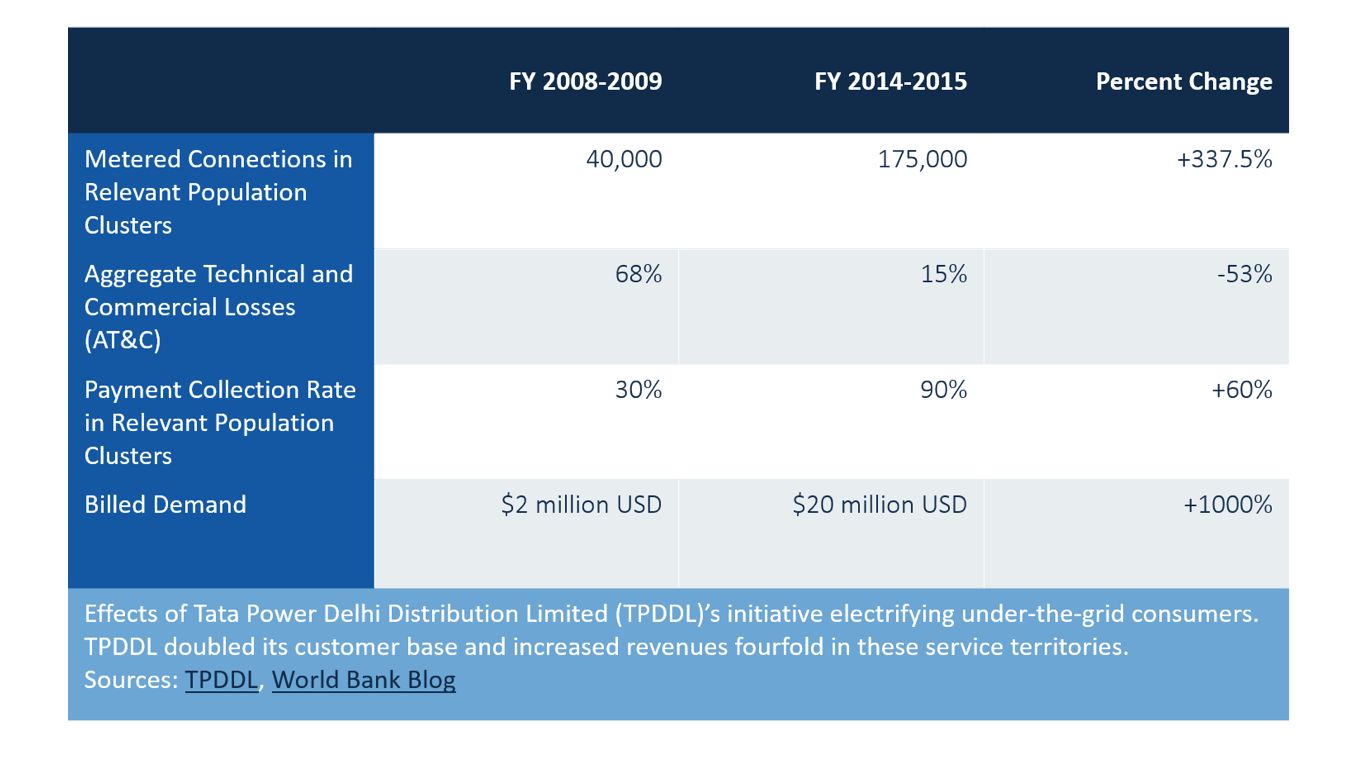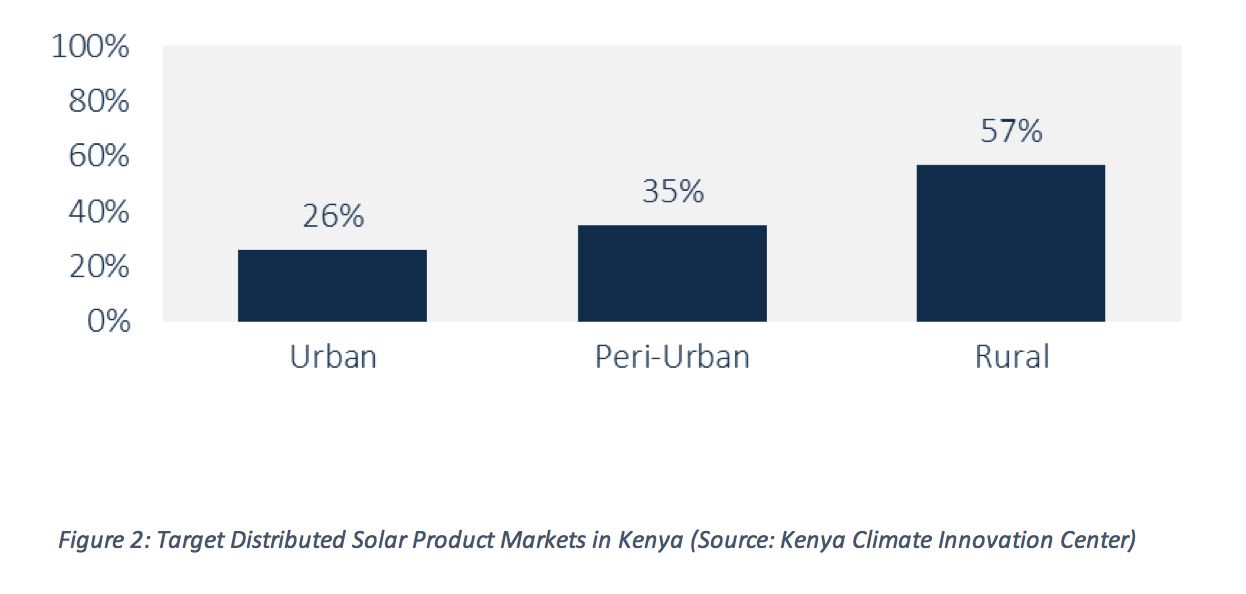Almost half of the people living in sub-Saharan Africa have access to electricity. Urban electricity access rates are even higher, estimated at 76 percent in 2014. But these figures are dangerously deceptive.
A recent World Bank study on infrastructure in Africa finds that take-up rates for populations living under the grid are high in only a few countries -- South Africa, Nigeria, Gabon and Cameroon -- while being below 50 percent in nearly every other country in the region.
A disproportionately large share of the unelectrified African population actually lives “under the grid” -- directly beneath existing grid infrastructure.
Estimates for "under-the-grid" populations differ by source. They range from 61 percent to as high as 78 percent.
At least 110 million of Africa’s 600 million people without electricity access live in urban areas, in close proximity to the grid. In this region -- the only place in the world where the aggregate proportion of the population with access to electricity is actually declining -- population growth will only cause the number of urban energy poor to grow over time.

Very little research has been done to understand the differentiated energy demands or consumption behaviors of peri-urban customers. Yet these households represent a massive commercial opportunity for cash-strapped sub-Saharan African utilities: tens of millions of densely packed customers without the high cost of last-mile rural grid extension. So what keeps these communities unconnected, and why?
Despite the lack of information, it is clear that one of the major barriers is the prohibitive cost of grid connection. The cost of a connection in Kenya, for instance, is estimated at USD $400 per household, nearly one-third of annual average per capita income and over four times the mean willingness to pay of surveyed Kenyans.
In Nigeria, 62 percent of under-the-grid grid households cite high connection costs as a reason they are not connected to the grid. The Center for Global Development estimates that there may be up to 95 million people living in under-the-grid areas in Nigeria, Kenya, Tanzania, Ghana and Liberia alone.
Beyond pure cost barriers, urban communities often experience persistent and pervasive energy isolation barriers due to economic and political remoteness (as opposed to geographic remoteness) and are neglected by large-scale public investment schemes.
Establishing a utility-customer relationship and billing channels can be difficult for people without a formal address or the ability to be metered. Likewise, residences close to other infrastructure (such as roads or railways), or in flood plains can create problems for all manner of service delivery. The state is usually unwilling, or legally unable, to provide infrastructure or services under such conditions.
Organizational barriers, corruption, power theft, ineffective bill collection methods, complicated interconnection, and service delivery complications also limit peri-urban energy access.
So how do utilities establish relationships with these elusive prospective customers? Turns out, an innovative private Indian utility figured this out years ago.
TPDDL: An Indian utility’s successes with onboarding the urban poor
In 2009, Tata Power Delhi Distribution Limited (TPDDL) focused on connecting an exclusive segment of its customer base living in impoverished neighborhoods.
By reducing new connection charges to a nominal 350 INR (about USD $7 at the time) offering an affordable 24-month payment plan, waiving outstanding dues, reducing proof of identification, relaxing commercial formalities on land rights, and promoting insurance offerings for those with metered connections, TPDDL made legitimate and reliable electricity connections affordable.
The utility also surveyed this "Special Consumer Group" to understand their needs and uses for electricity, and launched initiatives to help customers pay their electricity bills, such as providing supplementary services to communicate the value of a legal electricity connection. This included low-cost healthcare clinics with electronic equipment, vocational opportunities that required productive electric loads like sewing and milling, and hiring local women to serve as bill collection agents.
TPDDL now employs nearly 1,000 women in 39 impoverished neighborhoods to reduce theft. Collectively, they have brought 56,000 additional delinquent accounts to paying status.
Between 2010 and 2015, TPDDL’s unique model connected 175,000 new ratepaying customers in 217 impoverished neighborhoods near New Delhi. In the process, the utility doubled its customer base and increased its revenues fourfold.

Many of these lessons have been replicated in Jamaica, Brazil, South Africa, the Philippines and Kenya (where an estimated 70 percent of off-grid homes are located within 1.2 kilometers of a power line).
Kenya Power & Lighting Co. (KPLC) conducted a survey showing that customer willingness to pay for an electricity connection was 57 percent lower than the cost of service, but actual monthly expenditures were higher than the reported willingness to pay.
KPLC has taken lessons from TPDDL’s success, instituting a subsidized connection fee of USD $12 through the Last Mile Connectivity Project and an installment-based payment plan that led to a 30-fold increase in legal electricity connections in impoverished neighborhoods in one year.
Simple changes like making payments more convenient and affordable through e-billing, investing in local infrastructure beyond poles and wires, and a touch of creative customer engagement in marketing and bill collection are easy and effective mechanisms for improving uptake and customer retention.
In the case of TPDDL, changes like these reduced aggregate losses by 53 percent. Paired with a doubling of the customer base and a demand reduction to affordable levels of consumption for legal customers, the private utility was actually able to reduce the total electricity supplied to the impoverished neighborhoods in the program.
Decentralized renewables help bridge the gap
These solutions apply in Africa as well. In fact, yet another World Bank study published this year finds that for half of sub-Saharan African countries, the additional subsidies needed to make electricity affordable to every urban household are less than $5 million, and less than $1 million in 38 percent of them.
While almost two-thirds of SSA countries have low lifeline rates for customers using 100 kilowatt-hours or less per month, informal households are usually unable to take advantage of these reduced rates because multiple households often connect to the same meter, resulting in high total consumption at the meter. In fact, data shows that these households often end up paying disproportionately more for electricity. More effective targeting of this subsidy could drastically improve uptake.
Beyond reallocating energy subsidies toward connection fees and tariffs, increased support for decentralized renewable energy technologies is a major solution for under-the-grid electrification, especially in countries with less innovative utilities. Pay-as-you-go solar systems can provide a much lower barrier to entry to basic electricity services and back up illegal or unreliable grid connections.
For instance, compared to those high upfront connection costs noted earlier in Kenya, a 15-watt solar home system costs on average USD $9 per month for 36 months. The distributed renewable energy sector recognizes this market. In fact, about 35 percent of solar lighting product sales in Kenya are made in these peri-urban areas.
A number of off-grid solar companies, including d.light, have begun to specifically target peri-urban customers. Further, evidence has shown that the willingness to pay for decentralized renewables is proportionally much higher than grid connection, especially as reliability is an important user criteria.

Decentralized technologies are simple, fast and agile. They have short installation times and few permanent infrastructural features, thus offering a ready solution to those households on legally unserviceable land or in temporary housing situations.
Policies to support increased penetration of decentralized technologies include: increasing investment into the low- and medium-voltage distribution grid, simplifying grid interconnection procedures, and financial incentives like reduced duties for product import.
While much effort has been paid to bringing households into the physical grid, energy access is not binary -- rather, it is a gradient with “gray areas” of under-the-grid households willing to pay for reliable power.
With the right approach and simple innovations, sub-Saharan African utilities can capture elusive revenues and reliable payments from the 110 million prospective customers living under the grid.
***
This is the second installment in a joint series between GTM Research and Power for All exploring the dynamics of energy access issues in emerging markets. Power for All is a global coalition of 200 private and public organizations campaigning to deliver universal energy access before 2030 through the power of decentralized, renewable electricity.
As a pillar of Wood Mackenzie’s redefined focus on studying global trends in the transformation of power, GTM Research is studying the energy transformation occurring beyond the grid edge in the off-grid rural energy access space.




